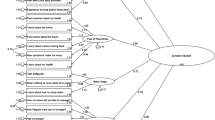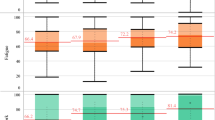Abstract
Goals of work
Symptom monitoring is described among rural cancer patients and survivors with comparison across study variables.
Materials and methods
An anonymous survey was mailed to adult cancer patients and survivors. Sampling was via a cancer center serving a region of a US rural-frontier state. Symptom monitoring was measured as keeping written track of symptoms, side effects, trends in how one is feeling, and/or limits to what one can do.
Main results
Useable response rate was 60.4% (134/222). Respondents were on average 62.3 years old, 53.0% were female, and 52.3% had earned less than a college degree. Breast (30.6%) and prostate (28.4%) cancers were most common. Symptom monitoring was reported and confirmed via tracking means, by 32.1% of respondents. Symptom monitoring was associated with “shared” or “passive” symptom management decisions, keeping written track of questions to ask providers and answers received, report of fatigue, and having received the suggestion or advice on how to monitor. Symptom monitoring was not associated with age, education, sex, number of symptoms, or being given something with which to monitor.
Conclusions
Symptom monitoring apart from intervention appears common among rural cancer patients and survivors. Findings support using multi-dimensional ways to inquire of, and refer to, such behavior. Data show symptom monitoring is more common among those suffering cancer-related fatigue, indicating opportunities for intervention to optimize monitoring for improved outcomes. Findings also suggest symptom-monitoring patients may rely on, or interact more with, providers regarding symptom management.
Similar content being viewed by others
References
Ajzen I, Fishbein M (1980) Understanding attitudes and predicting social behavior. Prentice Hall, Englewood Cliffs, NJ
Ashbury FD, Findlay H, Reynolds B, McKerracher K (1998) A Canadian survey of cancer patients’ experiences: are their needs being met? J Pain Symptom Manage 16:298–306 doi:10.1016/S0885-3924(98)00102-X
Basch E, Artz D, Iasonos A, Speakman J, Shannon K et al (2007) Evaluation of an online platform for cancer patient self-reporting of chemotherapy toxicities. J Am Med Inform Assoc 14:264–268 doi:10.1197/jamia.M2177
Bilodeau BA, Degner LF (1996) Information needs, sources of information, and decisional roles in women with breast cancer. Oncol Nurs Forum 23:691–696
Boyes A, Newell S, Girgis A, McElduff P, Sanson-Fisher R (2005) Does routine assessment and real-time feedback improve cancer patients’ psychosocial well-being? Eur J Cancer Care (Engl) 15:163–171 doi:10.1111/j.1365-2354.2005.00633.x
Brockopp DY, Hayko D, Davenport W, Winscott RN (1989) Personal control and needs for hope and information among adults diagnosed with cancer. Cancer Nurs 12:112–116 doi:10.1097/00002820-198904000-00009
Cassileth BR, Zupkis RV, Sutton-Smith K, March V (1980) Information and participation preferences among cancer patients. Ann Intern Med 92:832–836
Cleeland CS, Mendoza TR, Wang XS et al (2000) Assessing symptom distress in cancer patients: the M.D. Anderson Symptom Inventory. Cancer 89:1634–1646 doi:10.1002/1097-0142(20001001)89:7<1634::AID-CNCR29>3.0.CO;2-V
Degner LF, Sloan JA (1992) Decision making during serious illness: What role do patients really want to play? J Clin Epidemiol 45:941–950 doi:10.1016/0895-4356(92)90110-9
Desch CE, Smith TJ, Breindel CL (1992) Cancer treatment in rural areas. Hosp Health Serv Adm 37:449–463
Dillman DA (1999) Mail and internet surveys: the tailored design method, vol. 2. Wiley, New York
Fayers P (1995) MRC quality of life studies using a daily diary card—practical lessons learned from cancer trials. Qual Life Res 4:343–352 doi:10.1007/BF01593887
Fu MR, McDaniel RW, Rhodes VA (2007) Measuring symptom occurrence and symptom distress: development of the symptom experience index. J Adv Nurs 59:623–634 doi:10.1111/j.1365-2648.2007.04335.x
Ganther JM, Wiederholt JB, Kreling DH (2001) Measuring patients’ medical care preferences: care seeking versus self-treating. Med Decis Making 21:133–140 doi:10.1177/02729890122062389
Gaston CM, Mitchell G (2005) Information giving and decision-making in patients with advanced cancer: a systematic review. Soc Sci Med 61:2252–2264 doi:10.1016/j.socscimed.2005.04.015
Hack TF, Degner LF, Dyck DG (1994) Relationship between preferences for decisional control and illness information among women with breast cancer: a quantitative and qualitative analysis. Soc Sci Med 39:279–289 doi:10.1016/0277-9536(94)90336-0
Harris KA (1998) The informational needs of patients with cancer and their families. Cancer Prac 6(1):39–46
Hermansen-Kobulnicky CJ, Wiederholt JB, Chewning B (2004) Adverse effect monitoring: opportunity for patient care and pharmacy practice. J Am Pharm Assoc 44:75–88 doi:10.1331/154434504322713264
Hoekstra J, Bindels PJ, van Duijn NP, Schade E (2004) The symptom monitor. A diary for monitoring physical symptoms for cancer patients in palliative care: feasibility, reliability and compliance. J Pain Symptom Manage 27(1):24–35 doi:10.1016/j.jpainsymman.2003.06.005
Hoffman B, Stovall E (2006) Survivorship perspectives and advocacy. J Clin Oncol 24:5154–5159 doi:10.1200/JCO.2006.06.5300
Hofman M, Ryan JL, Figueroa-Moseley CD, Jean-Pierre P, Morrow GR (2007) Cancer-related fatigue: the scale of the problem. Oncologist 12(suppl 1):4–10 doi:10.1634/theoncologist.12-S1-4
Jemal A, Siegel R, Ward E, Murray T, Xu J, Thun MJ (2007) Cancer statistics, 2007. CA Cancer J Clin 57:43–66
Jenkins V, Fallowfield L, Saul J (2001) Information needs of patients with cancer: results from a large study in UK cancer centres. Br J Cancer 84:48–51 doi:10.1054/bjoc.2000.1573
Johnson JE (1999) Self-regulation theory and coping with physical illness. Res Nurs Health 22:435–448 doi:10.1002/(SICI)1098-240X(199912)22:6<435::AID-NUR2>3.0.CO;2-Q
Johnson JE, Fieler VK, Jones LS, Wlasowicz GS, Mitchell ML (1997) Self-regulation theory: applying theory to your practice. Oncology Nursing Press, Pittsburgh, PA
Kearney N, Kidd L, Miller M et al (2006) Utilising handheld computers to monitor and support patients receiving chemotherapy: results of a UK-based feasibility study. Support Care Cancer 14:742–752 doi:10.1007/s00520-005-0002-9
Kirkova J, Davis MP, Walsh D, Tiernan E, O’Leary N et al (2006) Cancer symptom assessment instruments: a systematic review. J Clin Oncol 24:1459–1473 doi:10.1200/JCO.2005.02.8332
Kroenke K, Spitzer RL (1998) Gender differences in the reporting of physical and somatoform symptoms. Psychosom Med 60:150–155
Leventhal H, Leventhal E, Schaefer P (1991) Vigilant coping and health behavior. In: Ory M, Abeles R (eds) Aging, health, and behavior. Johns Hopkins, Baltimore, MD, pp 109–140
Leventhal H, Nerenz DR, Straus A (1980) Self-regulation and the mechanisms for symptom appraisal. In: Mechanic D (ed) Psychosocial epidemiology 3: symptoms, illness behavior, and help-seeking. Neale Watson, New York, pp 55–86
Madan A, Borckardt J, Weinstein B, Wagner M, Dominick C et al (2008) Clinical outcomes assessment in behavioral healthcare: searching for practical solutions. J Healthc Qual 30(4):30–37
Miller SM (1995) Monitoring versus blunting styles of coping with cancer influence the information patients want and need about their disease: implications for cancer screening and management. Cancer 76:167–177 doi:10.1002/1097-0142(19950715)76:2<167::AID-CNCR2820760203>3.0.CO;2-K
Mullin SM, Fletcher DM, Tyler LS (1998) Mail-in questionnaire for monitoring nausea and vomiting in oncology outpatients. Am J Health Syst Pharm 55:1903–1906
Naliboff BD (2004) Choosing outcome variables: global assessment and diaries. Gastroenterology 126(Supp 1):S129–S134 doi:10.1053/j.gastro.2003.10.011
Oleske DM, Heinze S, Otte DM (1990) The diary as a means of understanding the quality of life of persons with cancer receiving home nursing care. Cancer Nurs 13:158–166 doi:10.1097/00002820-199006000-00005
Rowland D, Lyons B (1989) Triple jeopardy: rural, poor and uninsured. Health Serv Res 23:975–1004
Schumacher KL, Koresawa S, West C et al (2002) The usefulness of a daily pain management diary for outpatients with cancer-related pain. Oncol Nurs Forum 29:1304–1313 doi:10.1188/02.ONF.1304-1313
Sherliker L, Steptoe A (2000) Coping with new treatments for cancer: a feasibility study of daily diary measures. Patient Educ Couns 40:11–19 doi:10.1016/S0738-3991(99)00047-6
Skalla KA, Bakitas M, Furstenberg CT, Ahles T, Henderson JV (2004) Patients’ needs for information about cancer therapy. Oncol Nurs Forum 31(2):313–319 doi:10.1188/04.ONF.313–319
Spirig R, Moody K, Battegay M, De Geest S (2005) Symptom management in HIV/AIDS: advancing the conceptualization. ANS Adv Nurs Sci 28(4):333–344
Tucci RA, Bartels KL (1998) Patient use of the symptom reporting tool. Clin J Oncol Nurs 2(3):97–99
U.S. Census Bureau 2000 U.S. Census data. State and County Quick Facts. http://quickfacts.census.gov/qfd/states/56/56001.html. Accessed 3 Sep 2007]
U.S. Census Bureau 2000 U.S. Census data. Table 1a: Population in Metropolitan and Micropolitan Statistical Areas in Alphabetical Order and Numerical and Percent Change for the United States and Puerto Rico: 1990 and 2000 http://www.census.gov/population/cen2000/phc-t29/tab01a.pdf. Accessed 27 Oct 2007]
van der Molen B (2000) Relating information needs to the cancer experience. 2. Themes from six cancer narratives. Eur J Cancer Care (Engl) 9(1):48–54 doi:10.1046/j.1365-2354.2000.00190.x
Weinert C, Burman ME (1994) Rural health and health-seeking behaviors. Annu Rev Nurs Res 12:65–92
Wilde MH, Garvin S (2007) A concept analysis of self-monitoring. J Adv Nurs 57:339–350 doi:10.1111/j.1365-2648.2006.04089.x
Acknowledgments
Funding was provided in part by a grant from the American Association of Colleges of Pharmacy New Investigator Program for Pharmacy Faculty. Thank you to clinic physicians and staff who provided access to patients and mailing assistance, and to Shelby Chapman who served as research assistant.
Author information
Authors and Affiliations
Corresponding author
Rights and permissions
About this article
Cite this article
Hermansen-Kobulnicky, C.J. Symptom-monitoring behaviors of rural cancer patients and survivors. Support Care Cancer 17, 617–626 (2009). https://doi.org/10.1007/s00520-008-0552-8
Received:
Accepted:
Published:
Issue Date:
DOI: https://doi.org/10.1007/s00520-008-0552-8




